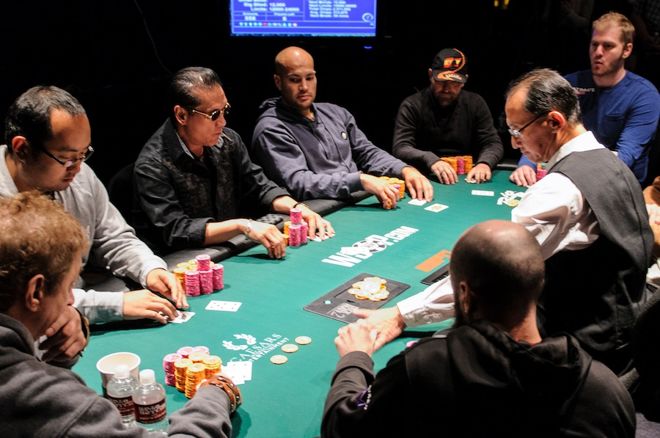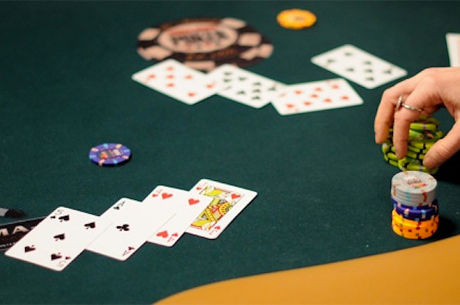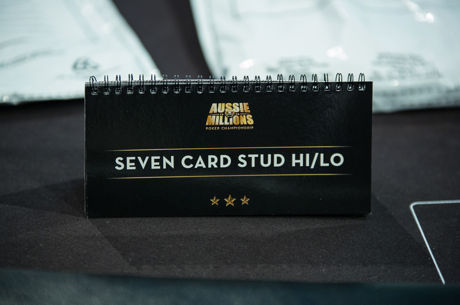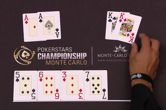Stud Strategy: Ante Stealing on Third Street

In the last two articles, I explored strategy differences between the typical (not high-stakes) stud game and World Series of Poker tournaments in which stud is played, either alone are as part of mixed-game events like H.O.R.S.E.
The strategic differences are chiefly due to the larger initial pot in the WSOP events and higher stakes stud games relative to the size of the initial bet. This larger initial pot requires more aggression in general, as your goal needs to be to knock other players out of the pot. In this column, we'll look at ante stealing on third street as another form of that desired aggression.
Keep in mind that ante stealing is something that the lowest stakes stud players rarely do, if ever. When the $1/$3 or $1/$5 game was typically spread in Las Vegas and in other public poker rooms (and as it is still spread in some places today), it usually doesn't even have an ante. In other words, the initial pot is limited to the $1 bring-in bet.
Obviously with such a tiny initial pot, it doesn't make sense to risk anything to steal it. But the larger cash games and the WSOP stud tournaments today all have an initial pot that is well worth stealing.
In general, you want to attempt to steal the ante whenever you have at least a fairly good chance of doing so. Admittedly, the phrase "a fairly good chance" is tough to quantify, so let's look at situations when it would be profitable.
Stealing from Late Position
The most obvious time to attempt a steal is when everyone has folded to you and just the bring-in remains. For example, say a hand is dealt and here are the cards showing:
Seat 1: 2?
Seat 2: 9?
Seat 3: Q?
Seat 4: 6?
Seat 5: 7?
Seat 6: 5?
Seat 7: Q?
Seat 8 (You): (2?3?) / A?
The 2? brings it in for $300 in this $1,000/$2,000 tournament level. The antes are $200 each, so with the bring-in the pot is $1,900.
If everyone folds to you with your A?, you complete the bet to $1,000, hoping to get the lone deuce to fold. If successful, you win a nice-sized pot.
The bet made sense because you only had one opponent who would have to have a pretty good hand �� or be fairly certain you were trying to steal �� to go up against you. Even if he had a pair, it wouldn't beat the pair of aces you were representing.
It was quite likely, in fact, that your lone opponent couldn't even beat your ace-high. So even if he knew with a fair degree of certainly that you didn't have a pair of aces, he might well fold here.
Stealing from Early Position
These situations when you're the high card and in last position don't present themselves very often, however. Consider a different variation on that theme. Instead of being last to go, let's imagine you're the first to go after the 2? pays the bring-in:
Seat 1: 9?
Seat 2: Q?
Seat 3: 6?
Seat 4: 7?
Seat 5: 5?
Seat 6: Q?
Seat 7: 2?
Seat 8 (You): (2?3?) / A?
Do you still attempt a steal? That depends on how often you think you'll be successful.
Let's say that based on your read of your opponents, from having seen their style over a couple of hours you figure you'll win uncontested with your early position steal attempt 50 percent of the time. Does it make sense then? Yes, it does �� 50 percent of the time you'll lose $1,000, 50 percent of the time you'll win $1,900. You'll be ahead, on average, $900 for every two times you try this move.
In fact, even if you're only going to succeed a third of the time, it still makes sense to make the steal attempt. At first, the math makes it look like a losing play. If you only won once in three times then you'd lose $2,000 in two attempts and win $1,900 in one attempt, for a net loss of $100 ($2,000 minus $1,900).
But that only tells part of the story �� the part that ends on third street. Keep in mind that even if your bet doesn't win you the pot with your initial steal attempt, you could still win the pot on fourth street or later. In reality, if you're called on third street you still get to see fourth street when you're dealt another card, and you might well win there.
There's another factor that makes your steal attempt from early position more likely to be successful than you might initially think. Just as raises from late position work as steals more often (because they require fewer opponents to fold), raises from early position are given more credit as not being steals. Thus when you raise with A? showing from early position, you're more likely to be given credit for having a pair of aces (and be less likely to be seen as ante stealing).
Stealing with the Highest and Second-Highest Up Card
Following similar logic to making steal attempts based on your position, consider how high your up card is relative to others' when you attempt a steal on third street.
Obviously, the most powerful up card is the highest one showing. If you have a king and no one shows an ace, your raise may well win you the pot right there because no one will have a higher pair (aside from the small chance someone has a pair of aces hidden), and so others won't want to take the chance that you have the pair of kings you are representing.
On the other hand, some of your better opponents may recognize that you are likely to view your high up card as an invitation to steal and therefore may not credit you with the pair you're representing. If they have a pair of jacks, for example, they may well reraise you. Ironically, if you attempt to steal with the second highest up card �� e.g., raising with a king when an ace remains to act �� your steal attempt may seem more credible to the sharp players, since they may reason that you would be unlikely to attempt a steal in that situation.
Consider, for example, the following hand:
Seat 1: 2?
Seat 2: 8?
Seat 3: Q?
Seat 4 (You): (6?8?) / K?
Seat 5: A?
Seat 6: 7?
Seat 7: J?
Seat 8: Q?
If the 2? brings it in and both the 8? and the Q? fold, your raise will generally appear to be genuinely representing a pair of kings. Unless the A? has another ace, your raise may well succeed in stealing the antes. Even if the J? or the Q? have a premium pair, they're likely to think, "Hey, he raised into the ace �� he must have me beat."
As you can see, much depends on your ability to figure out accurately what your opponents are likely to think your raise means. The better you are at figuring out your opponents, the better you'll be at correctly making these steal attempts.
Semi-Bluffing
There's another point you should consider when weighing the efficacy of an attempted ante steal. Up until now, all of our ante steals have been naked steal attempts �� with no other strength but the betting action. But you should also consider the added possibility of improving your hand on fourth street.
You might have hands like (A?10?) / Q? or (A?J?) / K?, or even (K?6?) / A?. In all three hands, you could easily improve to the best hand on fourth street even if you don't pair your door card. In the first example you might hit an ace or a ten; in the second, an ace or a jack; in the third, a king or any diamond.
All of those cards would improve your hand. They may not make your hand an immediate winner, but they may give you a reason to bet fourth and fifth street, causing your opponent to fold. Or you might even take the hand to the river and win.
Ante stealing with a back-up plan as in these examples is sometimes referred to as "semi-bluffing." It's a bluff that doesn't have to succeed immediately, because the hand might improve to the best hand on the next card and still win. That back-up plan gives your hand added value, and should be considered when deciding whether to make a steal attempt.
Ashley Adams has been playing poker for 50 years and writing about it since 2000. He is the author of hundreds of articles and two books, Winning 7-Card Stud (Kensington 2003) and Winning No-Limit Hold'em (Lighthouse 2012). He is also the host of poker radio show House of Cards. See www.houseofcardsradio.com for broadcast times, stations, and podcasts.









